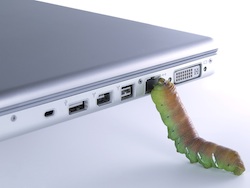In 2010, 25 percent of new worms have been specifically designed to spread through USB storage devices when connected to computers.
These types of threats can copy themselves to any device capable of storing information such as cell phones, external hard drives, DVDs, flash memories and MP3/4 players.

The data comes from Panda Security’s Second International SMB Security Barometer and suggests that the USB malware distribution technique is highly effective.
The results of a survey showed that approximately 48 percent of SMBs (with up to 1,000 computers) admit to having been infected by some type of malware over the last year. Additionally, 27 percent confirmed that the source of the infection was a USB device connected to a computer. The survey results were compiled from data gathered from 10,470 companies across 20 countries.
According to Luis Corrons, Technical Director of PandaLabs, “At present, much of the malware in circulation has been designed to distribute through these devices. Not only does it copy itself to these gadgets, but it also runs automatically when a USB device is connected to a computer, infecting the system practically transparently to the user. This has been the case with many infections we have seen this year, such as the distribution of the Mariposa and Vodafone botnets.”
So far, these types of infections are still outnumbered by those that spread via email, but it is a growing trend. “There are now so many devices on the market that can be connected via USB to a computer: digital cameras, cell phones, MP3 or MP4 players,” adds Corrons. “This is clearly very convenient for users, but since all these devices have memory cards or internal memory, it is feasible that your cell phone could be carrying a virus without your knowledge.”
How Does it Work?
There is an increasing amount of malware which, like the dangerous Conficker worm, spreads via removable devices and drives such as memory sticks, MP3 players and digital cameras. The basic technique used is as follows: Windows uses the Autorun.inf file on these drives or devices to know which action to take whenever they are connected to a computer. This file, which is on the root directory of the device, offers the option to automatically run part of the content on the device when it connects to a computer. By modifying Autorun.inf with specific commands, cyber-crooks can enable malware stored on the USB drive to run automatically when the device connects to a computer, thus immediately infecting the computer in question.














